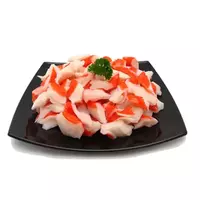Frozen crab meat

Such a product as frozen crab meat appeared on the shelves of domestic grocery stores about 29 years ago. It is worth noting that the skillful imitation of natural crab meat quickly gained popularity and began to be in demand among the inhabitants of our latitudes. Currently, chilled or frozen crab meat, as well as crab sticks, are considered an indispensable attribute of some common salads and snacks.
Composition of crab meat
Crab meat includes far from natural meat from the famous crustaceans. Crab meat includes minced fish, the so-called surimi or 擂り身. Literally translated from Japanese, surimi denotes finely chopped meat of certain varieties of fish. As a rule, pollock meat, iwashi, as well as mackerel and herring are used for surimi. Notably, the surimi mince itself does not have a pronounced taste or aroma, so the product is often used to simulate crab meat.
Crab meat or surimi was first made back in 1100, when the Japanese noticed the distinctive consumer properties of a product based on white fish. Over time, various figures began to be made from surimi, which gradually transformed into a modern kind of crab sticks, as well as chilled or frozen crab meat.
The calorie content of crab meat is at a fairly low level. The average calorie content of crab meat is about 73 Kcal, which are contained in 100 grams of the product. However, crab meat from different producers differs not only in its appearance and taste characteristics, as well as in its chemical composition and calorie level. It is believed that the color of quality chilled or frozen crab meat should be white.
The benefits of crab meat
The gray hue of the product indicates the low quality of the raw materials that were used to make crab meat. Debate about the harms and benefits of crab meat has been ongoing to date. As is often the case, there are two diametrically opposed opinions on the benefits of crab meat.
Some believe that as a fish product, crab meat refers to dietary foods, which contain a certain amount of vitamins, as well as natural compounds useful for the human body. However, in addition to fish mince, surimi, the chemical composition of crab meat contains food additives and starch.
Since the taste, aroma, as well as the color of crab meat is formed exclusively due to preservatives, dyes and flavor enhancers, it is hardly worth talking about the benefits of the product. Rather, it is worth avoiding the frequent consumption of an artificial substitute for crab meat, since such an abundance of various synthetic food additives in the food composition simply cannot but have a negative effect on the digestive system of the human body.
frozen crab meat 73 kCal
Energy value of frozen crab meat (Ratio of proteins, fats, carbohydrates - ju):
Proteins: 6 g (~ 24 kCal)
Fats: 1 g (~ 9 kCal)
Carbohydrates: 10g (~ 40kCal)
Energy ratio (bj | y): 33% | 12% | 55%
 Español
Español Français
Français Português
Português Русский
Русский 简体中文
简体中文 繁體中文
繁體中文 日本語
日本語 한국어
한국어 العربية
العربية Türkçe
Türkçe Қазақ
Қазақ Deutsch
Deutsch Italiano
Italiano Українська
Українська
